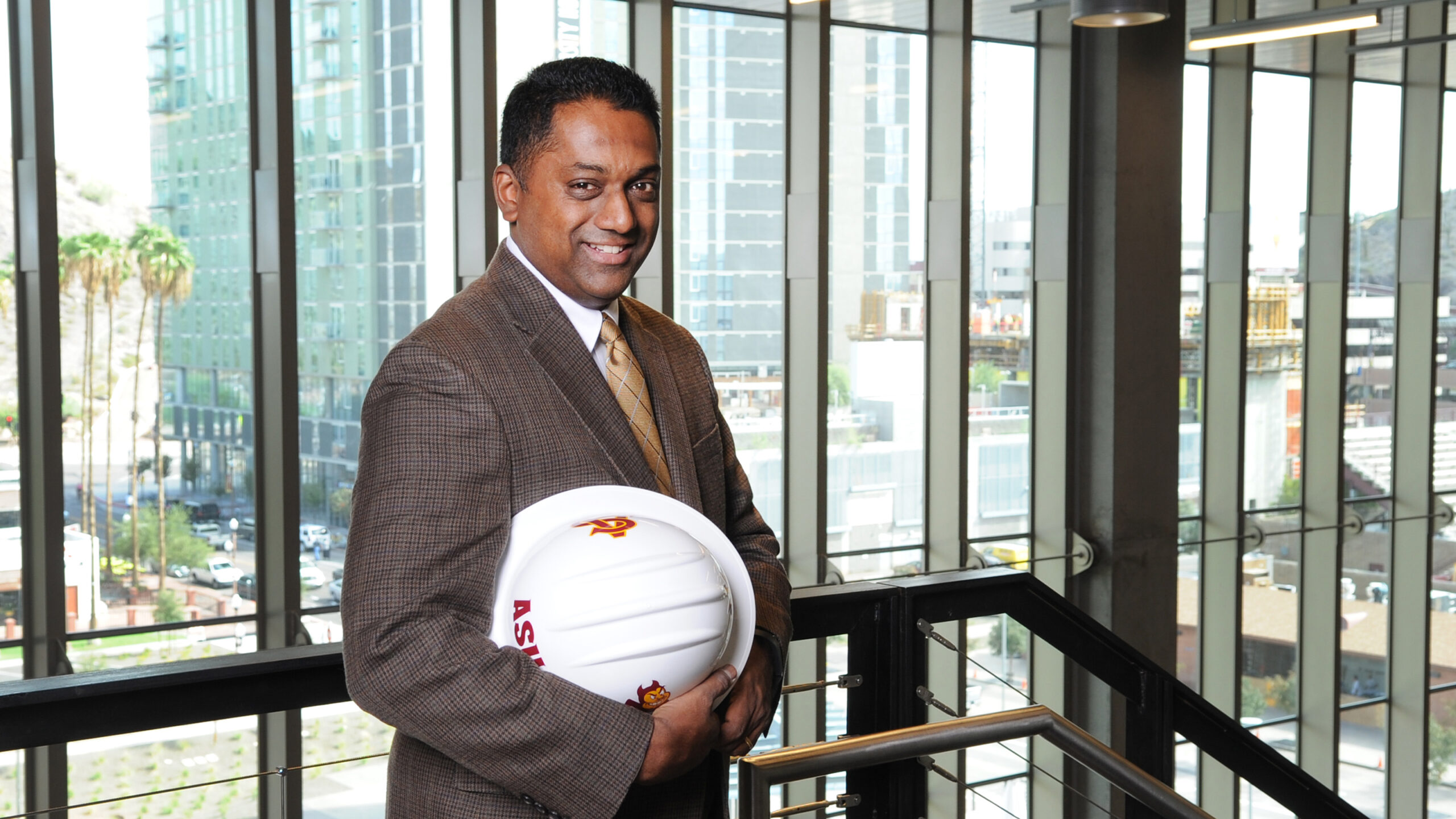
Samuel Ariaratnam named Beavers-Ames Chair in Heavy Construction

Above:Sam Ariaratnam was named the Beavers-Ames Chair in Heavy Construction at ASU, a professorship designed to encourage students to pursue careers in heavy construction and connect them with professionals in the heavy construction industry. Photographer: Tim Trumble
Samuel Ariaratnam, professor and chair of the construction engineering program in the Del E. Webb School of Construction at Arizona State University, has been named the Beavers-Ames Chair in Heavy Construction after years of involvement with the organization.
The Beavers-Ames Chair in Heavy Construction was established at ASU to bolster construction management and engineering education for undergraduate students and to promote the heavy construction industry.
“Sam’s passion, energy and enthusiasm for all that we do in our enterprise is unparalleled. He is the first to step up to help advance an initiative or champion a cause,” says Ram Pendyala, the director of the School of Sustainable Engineering and the Built Environment, one of the six schools in the Ira A. Fulton Schools of Engineering. “He always makes time to engage, collaborate and brainstorm new and exciting ideas. Even in the midst of the pandemic replete with Zoom meetings and virtual engagements, Sam has consistently walked the halls of College Avenue Commons to knock on doors, connect in person and check on the welfare of others.”
The position honors Bill Ames and Wink Ames, who passed away in late 2020, and was established by trustees of the Beavers Charitable Trust in recognition of the Ames family’s generations of support of the construction industry and construction education in California and Arizona.
“I want to recognize Wink Ames, as he was a wonderful man and he was such an inspiration to our program,” Ariaratnam says. “Since I arrived here on faculty in 2001, he was always a big supporter of what we do at ASU and in the construction programs, and I’m honored to be the Beavers-Ames Chair of Heavy Construction to be able to continue some of the great things that he did.”
The Beavers’ investment in the professorship is with the goal of encouraging students to pursue careers in the heavy construction industry and help them foster connections with professionals in the industry.
“In today’s environment, the typical hiring for permanent employment of graduates involves summer internships that provide both the student and a company time to determine if they are a good fit,” says Dave Woods, the executive director of the Beavers. “We hope that partnering with Dr. A will create opportunities for students to find internships and permanent jobs with heavy civil contractors, ideally Beavers member companies.”
A career of contributions to trenchless technology
Ariaratnam’s contributions to the heavy construction industry are extensive. He has served on the North American Society for Trenchless Technology board of directors from 2001 to 2006, and was the chairman of the International Society for Trenchless Technology from 2010 to 2013 and chair of the American Society of Civil Engineers Pipelines Division Executive Committee from 2017 to 2018.
Throughout his career, Ariaratnam has earned five patents, written eight books, and published more than 300 technical papers in his research area, which focuses on trenchless construction methods, horizontal directional drilling and trenchless pipe replacement. Ariaratnam was elected to the Canadian Academy of Engineering in 2018 and the National Academy of Construction in 2019.
“Trenchless technology looks at underground facilities and the installation of new underground utilities or the repair of existing ones,” Ariaratnam says. “This could be telecommunications systems, water, sewer, electrical, gas, oil and petroleum pipelines. Trenchless technology is a way of minimizing disruption to surface activities.”
Open-cut construction, which is the traditional and most popular method for installing and repairing underground utilities, can be compared to open heart surgery — a procedure with a large incision and long recovery time.
By contrast, trenchless technology is similar to an angioplasty, which involves equipment such as probes and cameras to make repairs and installations with minimal surface disruptions and minimal downtime. With trenchless technology, the system is almost immediately functional after installations and repairs are made.
“These types of infrastructures are very critical for day-to-day life and the betterment of society,” Ariaratnam says. “Being this chair will help me continue to get the message out about the importance of the heavy construction industry.
Serving the next generation of students
Ariaratnam plans to use this new endowed chair to promote heavy infrastructure and heavy construction education in the School of Sustainable Engineering and the Built Environment.
“I’m going to help build on and enhance the curriculum,” Ariaratnam says. “Any of our students in construction management, construction engineering and civil engineering could be interested in pursuing that pathway for heavy construction. So, one of my most important roles is to help connect students with mentors in the industry.”
Ariaratnam also notes that many people in the heavy construction industry are also members of the Beavers Trust, and he hopes to engage students through those connections. Besides residential, commercial and industrial construction, there are several different areas of the industry for ASU students to explore including heavy construction.
“The heavy construction industry has been my focus in teaching and research, and I want to continue to be a champion of that, representing ASU and the Beavers-Ames Chair,” Ariaratnam says. “That includes sharing my research at various conferences and different industry events, getting students more engaged in research activities and helping them gain an appetite for being part of the heavy construction industry.”
Pendyala says of Ariaratnam’s honor, “It is truly a well-deserved title that recognizes his 25 years of teaching, research and service, 20 of which he has devoted to ASU.”



































